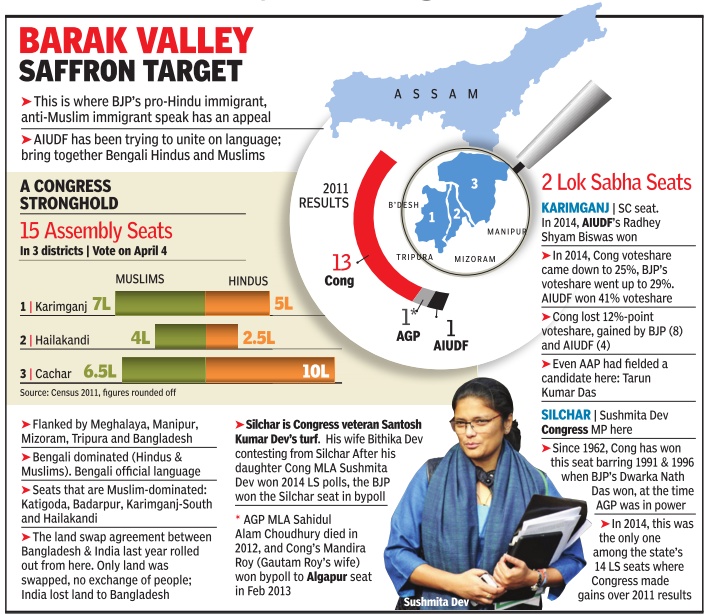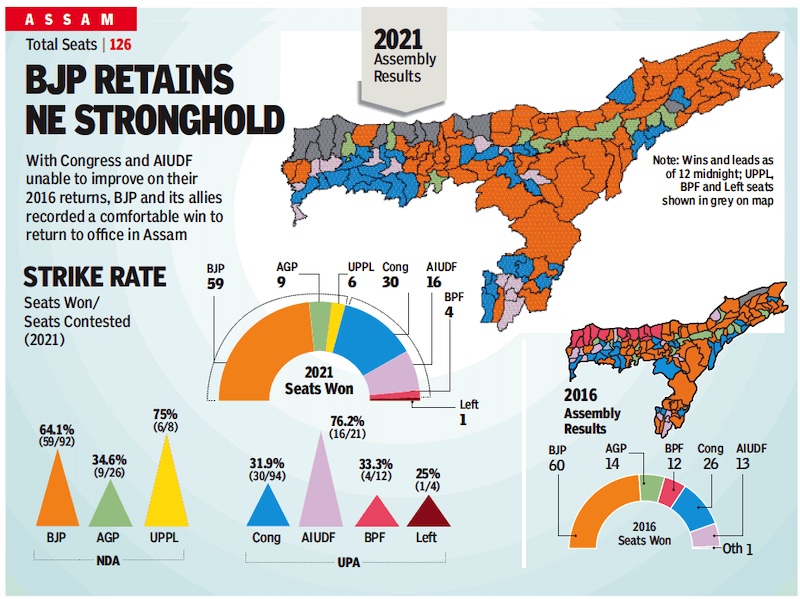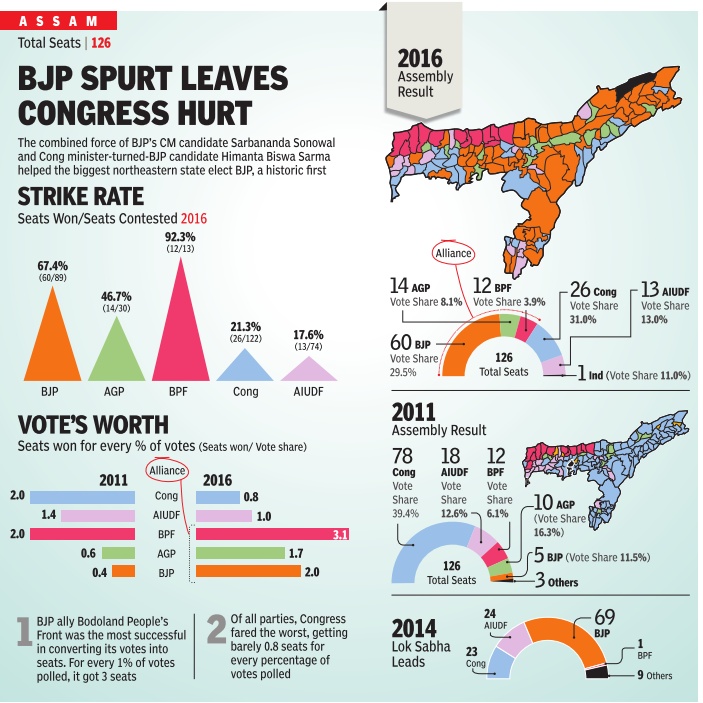Assam: Assembly elections

This is a collection of articles archived for the excellence of their content. |
Contents |
History
1951-2016

From: May 3, 2021: The Times of India
See graphic:
Parties that won and came second in the Assam Assembly elections, 1951-2016

Graphic courtesy: The Times of India, April 22, 2016
See graphic
Vote shares of major parties, Assam, 2011-14
2021
NDA wins again
Prabin Kalita , May 3, 2021: The Times of India

From: May 3, 2021: The Times of India
With a new combination, the NDA is set to retain Assam for the second successive term clearing CAA and incumbency hurdles and beating Mahajot of Congress, AIUDF, BPF and Left parties.
Till 10.30pm, the EC had declared results of 70 of 126 seats and trends of remaining 56. The NDA has so far won 47 seats and was leading in 26 while Congress and its Mahajot has won 23 seats and was leading in remaing 28. In two seats, two independents were leading. In 2016, the NDA had won 87 seats.
But no party looks to be on course to make it past the halfway mark of 63 in the house of 126 alone. BJP is likely to finish as the single largest party with 60 seats, which would be construed as no improvement given the fact that it had won the same number of seats five years back. AGP’s number of seats has come down from14 in 2016 to eight and the alliance’s new partner UPPL had managed to win five out of 12 seats in BTC till the last update.
“We will have an absolute majority. A stronger opposition means a healthier democracy,” Himanta Biswa Sarma said but didn’t want to go into the analysis of the results in view of the Covid-19 situation.
The election, which was fought on the issue of protecting Assam’s identity, got strongly polarised on religious lines and is likely to give four more seats to Congress and two more to AIUDF than in 2016.
What helped BJP survive the CAA fire was its ability to project NRC as an antidote to the CAA and its pledge to implement Clause VI of the Assam Accord, which proposes to protect the identity of indigenous Assamese people. Ironically, NRC and Clause VI are Congress’s creations while CAA is BJP’s brainchild. BJP also benefited from the votes cut into by anti-CAA parties AJP and Raijor Dal, which otherwise would have gone to Congress.
“This election was definitely the battle for Assamese culture and Assamese civilisation and the mandate has been given to BJP to protect them. There was also PM Narendra Modi’s push for development that steered BJP,” Sarma said.
Chief minister Sarbananda Sonowal and Himanta Biswa Sarma have both won their seats of Majuli and Jalukbari respectively. NDA partner AGP’s president Atul Bora has also won from Bokakhat.
Congress president Ripun Bora, who had projected himself as a CM face for Congress, was defeated, while three BPF ministers of the outgoing government lost to UPPL. Peasants’ leader Akhil Gogoi, the sole winner of Raijor Dal, has become the second candidate to win an assembly election in the state from judicial custody.
”2016 was about deporting aliens, 2021 threat to locals’ identity”
Kangkan Kalita1 , May 3, 2021: The Times of India
Unlike the 2016 election, which revolved round PM Narendra Modi and his vow to free Assam of infiltrators, this year’s election concerned the identity of Assamese and indigenous people.
Most of Assam erupted in protests in December 2019, when the Centre passed the Citizenship (Amendment) Bill. Five people were killed and numerous others injured in the anti-CAA movement that sparked a chain reaction across the valley. Leading organisations like the All Assam Students’ Union (Aasu), Krishak Mukti Sangram Samiti (KMSS) and Asam Sahitya Sabha expressed solidarity with the protesters.
While the saffron camp’s narrative for safeguarding indigenous identity was to resist the “aggression of migrant Muslims” of Bengali origin, ethnic organisations refused to buy the argument and switched to war mode to thwart the CAA.
But on Sunday, it was BJP’s narrative that came out tops. “The people of Assam believed us,” said BJP spokesperson Rupam Goswami.
Aasu president Dipanka Kumar Nath said that rather than identity, BJP’s welfare schemes helped it sail through. “Perhaps the common voters felt relieved for the time being due to the numerous beneficiary schemes of the BJP-led government like free rice, direct cash transfer, two-wheelers for students and the promise of waiving microfinance loans,” Nath said.
Pact with AIUDF cost Congress
Kangkan Kalita1 , May 3, 2021: The Times of India
Assam punished Congress, which was the ruling party in the state for decades, for deviating from the Tarun Gogoi path and joining hands with Badruddin Ajmal’s AIUDF.
The late Congress stalwart, who served as the CM of Assam for a record three consecutive terms from 2001-2016, would often deride Ajmal, a perfume baron, as ‘an outright communal politician’. Gogoi softened his stand on Ajmal before his death, when the two parties were inching closer for a poll deal last year. But Gogoi had already passed away in November last year before the prepoll deal was sealed.
There was opposition from a section of Congress, who were not happy with the association with AIUDF. Many feared that bringing AIUDF into its fold would prove costly for the party in upper Assam, which was the epicentre of the anti-CAA agitation. There was fear in the hearts of ethnic communities that ‘infiltrators’ from Bangladesh would take over Assam if Ajmal’s party started dictating terms to the government.
BJP’s key strategist Himanta Biswa Sarma also targeted Congress in a number of poll rallies for allegedly putting ‘Assam’s civilisation at risk’ by forging an alliance with AIUDF. “AIUDF leaders did not come to upper Assam during Congress campaign because they were well aware of the hatred of the indigenous people towards them. Congress was solely rejected because of forging an alliance with AIUDF, which was not expected from them,” said Asom Gana Parishad president Atul Bora, who won from Bokakhat.
The Congress-AIUDF alliance expected significant gains in lower Assam and Barak Valley, where minority voters play a determining role in elections. But it proved detrimental for Congress in the upper and northern Assam constituencies where the first phase polls were held for 47 seats, highest in terms of seats in the three-phase election. While some of the Congress leaders from upper Assam anticipated loss due to prepoll understanding with AIUDF, a few other Muslim leaders of Congress in lower Assam initially opposed joining hands with Ajmal, fearing that AIUDF would take over its traditional Muslim votebank.
Assam Pradesh Congress Committee president Ripun Bora blamed money power and communal politics for the poor show of Congress in upper Assam, which was its bastion once. “I take moral responsibility for the defeat. But I don’t think we lost because of AIUDF. There was false propaganda. Ours was a Mahajot or grand alliance of many parties,” Bora said.
Regional parties split votes, help BJP win
Kangkan Kalita1 , May 3, 2021: The Times of India
The Assam Jatiya Parishad (AJP) and Raijor Dal (RD), two new political parties born out of the anti-CAA movement, not only failed to make a mark in the elections but also ended up helping BJP, their main opponent, by splitting opposition votes.
Insiders in both the parties blamed Congress’ decision to ally with AIUDF, which many caste Assamese organisations call a ‘communal party’. And this is being seen as the prime reason for votes swinging in BJP’s favour.
Only RD could open its account by sending its president and jailed peasant leader Akhil Gogoi to the assembly from the Sivasagar seat. “Had there been a united fight from anti-BJP parties, they could have inched closer to forming the government. Division of votes, mainly in upper Assam, helped BJP win,” said lawyer Santanu Barthakur.
Political science professor at Gauhati University, Akhil Ranjan Dutta, said the two parties failed to choose diversity of issues, while focusing on the issue of anti-CAA sentiments.
Barak Valley
The Times of India, March 29, 2016
B B Goswami & Naresh Mitra
Why a lotus bloom is so crucial for BJP in the valley of high stakes
For BJP , the battle for the Bengalidominated Barak Valley in Lower Assam is a high-stakes game. In the 1991 assembly polls, it put in a stunning performance here winning 9 of the 15 seats. But it lost ground to the Congress subsequently .This time around, the saffron party hopes to reverse fortunes and snatch lost territory from the ruling party for a maiden shy at office. Contesting 91 seats in the state this time, leaving about 35 to allies, the BJP is the only party in the formation it heads that has any appeal in the valley. The AGP , an Assamese outfit, has little traction in the valley . Similarly , the Bodo People's Front holds sway in areas where their community is in a majority . That makes the 15 Barak Valley seats so much more crucial.
Conscious of this reality , the BJP has focused firepower here. The Prime Minister campaigned in Silchar. The valley has a sizeable Bengali Hindu presence, but over the years the Bengali Muslim population has risen sharply , in fact they are in a majority in four assembly seats.
This makes BJP's task more challeng ing. In 1947, the region's overwhelmingly Hindu population stopped it from being lumped with East Pakistan. Today , the Barak valley has a Muslim population of over 50%. While Hindus are a majority in Cachar, Muslims dominate Hailakandi and Karimganj.
This is why the NDA govern ment's promise to grant citizenship status to all refugees of religious minorities fleeing Bangladesh got trac tion among Hindus here.But the government's subsequent silence has made the region restless. PM Naredra Modi skipped the issue in his speech near Silchar.
In 2011, the region's Bengali Hindu population went strongly with the Congress, consolidating against a fastrising All India United Democratic Front of Badruddin Ajmal. Gogoi's party swept 13 of the valley's 15 seats.
“Our strength has grown since the 2014 LS polls. The anger against Congress is strong. This time, we expect to do well,“ Assam BJP vicepresident and candidate for North Karimganj Mission Ranjan Das, said.
Assam PCC spokesman Deepan Dewanjee said his party would sweep Barak Valley . But the party is hob bled by the absence of senior politicians such as Santosh Mohan Deb. In the 2014 LS polls, BJP failed to win any of the two parliamentary seats in the valley. The party had leads in three of the 15 assembly seats. Congress won the Silchar LS seat and Ajmal's AIUDF won Karimganj. Later, BJP wrested the Silchar assembly seat from Congress in a bypoll.
2016: BJP ends 15-year Congress reign

The Times of India, May 20 2016
BJP took a big leap for ward in its bid to expand its base in the northeast by handing out a humiliating defeat to arch-rival Congress with the help of its two regional allies, Asom Gana Parishad (AGP) and Bodoland People's Front (BPF).
The victory , which comes after two major debacles in Delhi and Bihar, will allow the saffron party to govern a state that has the country's second-highest Muslim population after Jammu & Kashmir. At least 35 of Assam's 126 assembly seats have more than 50% Muslim voters.
BJP, which got a mere five of 120 contested seats in 2011, won 60 seats at a high strike rate this time. It had fielded candidates in 89 constituencies. On the contrary , Congress got 20 seats, far below its tally of 78 in the last election. The success in Assam, which comes as a morale booster at a time when BJP is preparing for a tough contest in Uttar Pradesh, Punjab and Gujarat, is set to help the saffron party make inroads into more areas of the northeast.
At the moment, BJP has tie-ups with the Naga People's Front, which rules Christian-dominated Nagaland, and People's Party of Arunachal, currently in power in the frontier state. The win has also brought cheer to BJP supporters in Manipur, which goes to the polls early next year. Meghalaya, Mani pur and Mizoram are the three states that have a Congress government at the moment. AGP also made its mark by winning 14 of the 24 seats it contested. BPF retained all the 12 seats it had won as a partner of Congress in 2011. The Bodo organisation had contested 13 seats. Like Congress, All India United Democratic Front, too, suffered a serious setback. Its tally went down to 13 from 18.Not only this, its chief, billionaire perfume baron Badruddin Ajmal, lost in Salmara South in the Muslim-dominated Dhubri district that borders Bangladesh.
The defeat of Congress also saw the end of Gogoi's 15year rule. The outgoing CM had surpassed all his predecessors, including the legendary Gopinath Bordoloi and B P Chaliha, to become Assam's longest-serving CM.
The results revealed a shift in loyalties in Muslim, Ahom and tea belts. While Congress snatched six seats from AIUDF in minority-dominated lower and central Assam, tea workers, traditional Congress supporters, overwhelmingly voted for BJP . In the Ahom homeland of upper Assam, too, Congress performed miserably. Gogoi is an Ahom.